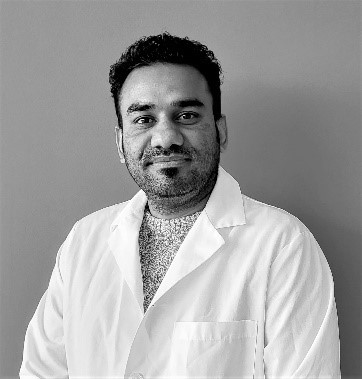Early Career Editorial Board Member Interview: Yogendra Pratap Singh
Published 28 April, 2025
Dr. Yogendra Pratap Singh is a Professor Grade 1 at the School of Healthcare Science and Engineering (SHINE), Vellore Institute of Technology (VIT) Vellore, India. He earned his Ph.D. in Tissue Engineering from the Indian Institute of Technology Guwahati (IITG), where he developed novel silk-based biomaterials for cartilage and osteochondral tissue engineering. Following his doctoral work, he pursued postdoctoral research at Penn State University (USA), where he worked at the forefront of state-of-the-art 3D bioprinting technologies, focusing on intraoperative bioprinting and high-throughput tissue biofabrication.

Dr. Yogendra Pratap Singh
Professor Grade 1 at the School of Healthcare Science and Engineering (SHINE), Vellore Institute of Technology (VIT) Vellore, India.
Currently, Dr. Singh’s research is centered on Bioinspired Bioengineering, with a strong emphasis on the development of immunomodulatory bioactive materials for enhanced tissue regeneration, implant acceptance, and disease modeling.
Dr. Singh has received several prestigious international fellowships, including the Newton Bhabha Fellowship (UK), and Raman-Charpak Fellowship (France). He has authored over 25 peer-reviewed research publications, contributed book chapters and patents, and has been recognized for his contributions to biomaterials and regenerative medicine. He actively serves on multiple editorial boards, including the Early Career Editorial Board of Bioactive Materials and the Youth Editorial Board of the International Journal of Bioprinting.
Here is the interview we did with him:
- Could you briefly introduce the specific focus of your current research within the broad area of bioactive materials?
My current research lies at the intersection of Bioinspired Bioengineering and Immunomodulatory Biomaterials. I focus on developing smart materials that can actively communicate with the body’s immune system to promote implant acceptance and guide tissue regeneration. This includes designing 3D bioprinted constructs, engineering immunoprotective devices, and building in vitro disease models to better understand immune-tissue interactions in a controlled environment.
- In the context of researching bioactive materials, what unique obstacles or difficulties have you faced?
One of the biggest challenges is translating immunological insights into material design. The immune system is incredibly dynamic and creating materials that can adapt intelligently without triggering unwanted responses is a complex task. On top of that, ensuring reproducibility and scalability, especially when working with biologics like vesicles or cells, poses technical and logistical hurdles.
- How do you stay updated with the latest advancements in research, considering the rapidly evolving nature of the field?
I stay informed through a combination of regular literature reviews, preprint servers, and by following key researchers and journals on platforms like LinkedIn and X. I also actively engage in editorial work, attend conferences, and participate in collaborative networks, which provide first-hand exposure to emerging trends and unpublished work. Being part of editorial boards like Bioactive Materials also offers a unique vantage point to observe where the field is headed.
- What were the key factors that attracted you to become an early career editorial board member of Bioactive Materials?
I saw this as an excellent opportunity to contribute to shaping the future of the field, support my peers, and learn more about the editorial process. Bioactive Materials has a strong reputation for publishing impactful, interdisciplinary research that bridges biology, materials science, and medicine. The opportunity to work alongside a distinguished editorial team, guided by respected Editors-in-Chief, also allow me to grow professionally and learn from the best in the field.
- From your perspective, what are the most promising directions for the future development of bioactive materials?
I believe the future lies in smart, adaptive biomaterials which can respond to the microenvironment in real-time, modulate immune responses, and integrate multiple therapeutic functions. Areas like immune engineering, organ-specific regeneration, and AI-guided biomaterial design are particularly promising. There’s also growing potential in biomaterials for in vitro disease modeling, which could accelerate drug screening and reduce dependence on animal models.
- As an early career editorial board member, what initiatives do you plan to take to engage more early-career researchers with the journal and the field of bioactive materials?
I’m passionate about building a sense of community among early-career researchers. I hope to initiate special issues led by young investigators, feature spotlight articles that amplify emerging voices, and possibly organize webinars and panels focused on scientific publishing, peer review, and research storytelling. I also see social media as a powerful tool to make the journal more engaging, accessible, and inclusive for the next generation of biomaterials scientists.
- Beyond your scientific endeavors in bioactive materials, what is your favorite pastime?
I enjoy long-distance running. It’s meditative and often helps me think through complex ideas. I also love spending time in nature, which offers both inspiration and clarity. And whenever I can, I engage in science communication and mentoring, which I find deeply fulfilling.
- Given the demanding nature of scientific research, how do you manage to strike a balance between your research work and your personal life?
I believe achieving balance is a conscious effort. I set boundaries to make space for activities like exercise, family time, and reflection. I've learned that rest isn’t a luxury, it’s essential for creativity and long-term productivity. Building a supportive work environment and surrounding myself with a collaborative team also makes it easier to maintain that equilibrium.

